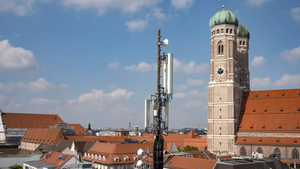
It all started in 2018, when AT&T decided to rebrand its 4G LTE network with the "5Ge" label. In one quick, contentious action, the operator kicked off years of marketing and branding arguments about what is "true" and "real" 5G.
Caught in the midst of the battle were consumers bludgeoned with 5G marketing buzzwords ranging from "5G Ultra Wideband" to "5G Ultra Capacity" to "Extended Range 5G."
This week though, AT&T brought things full circle by announcing the brand for its forthcoming midband 5G network, running on the C-band spectrum holdings it spent almost $30 billion acquiring. The brand?
5G+
"How will you know if you are in an area with the faster C-band or mmWave 5G? You'll see an indicator that simply shows '5G+,'" wrote AT&T's Mo Katibeh in a post to the company's website titled "AT&T is preparing for the next wave of 5G+."
In clarifying its 5G branding, AT&T is basically planning to implement the exact same marketing strategy as Verizon. However, it's not yet clear whether AT&T will engage in the same kind of profiteering Verizon plans to employ by charging customers extra for access to the speedy version of its 5G network.
From 5Ge to 5G+
AT&T's long, strange trip to "5G+" started with a decision in 2018 by its former management team to simply rebrand its 4G network into a 5G network. Although the decision sparked plenty of condemnation, it quickly and easily gave AT&T a response to Verizon's big launch of the millimeter wave (mmWave) version of 5G. Verizon branded that network as "5G Ultra Wideband," or simply 5G UWB. As Verizon sought to encourage potential customers to switch over to its small but speedy 5G UWB network, AT&T gave all its customers 5G – without spending any money – by simply changing the icon on their phones from "4G LTE" to "5Ge." Doing so gave AT&T a strategic response to Verizon's 5G advertising campaign – its customers already had 5G, so why did they need to switch?
But AT&T also launched a mmWave 5G service to compete with Verizon. It branded that offering as "5G+."
Then, in the intervening years, AT&T, Verizon and T-Mobile all expanded 5G to their lowband spectrum holdings. That necessitated another round of 5G branding, in order to separate it from the mmWave flavor of 5G. Verizon called it "5G Nationwide," T-Mobile called it "Extended Range 5G" and AT&T called it simply "5G." However, such networks aren't much faster than 4G.
And then T-Mobile launched its midband 5G service. The midband flavor of 5G offers a compelling balance of both speed and coverage. T-Mobile branded its midband 5G network as "5G Ultra Capacity." That network – running on T-Mobile's 2.5GHz spectrum – today covers around 185 million people with average speeds above 200 Mbit/s.
In order to build their own midband 5G networks, Verizon and AT&T both spent billions of dollars on C-band spectrum licenses earlier this year. But how to brand that new offering?
Verizon, for its part, said it plans to extend its "5G UWB" brand to its forthcoming C-band network. And now it's clear AT&T will do the same: The operator will extend the "5G+" brand it's using for mmWave 5G to its forthcoming midband C-band network.
5G profit strategies
As Verizon, AT&T and T-Mobile all rush to update their networks with 5G technologies – whether faster than 4G or not – they are all also working to make more money from the effort.
Verizon's strategy has been the clearest: In the early days of its mmWave 5G launch, it attempted to charge customers an extra $10 per month for the service. However, the operator quickly backed off that plan amid complaints of the network's tiny coverage area.
Now, as Verizon nears the launch of its 5G C-band network, it plans to employ a related strategy: It won't provide 5G UWB services to its customers unless they subscribe to one of its expensive, premium unlimited data plans.
T-Mobile, for its part, has not engaged in this type of profit strategy. Instead, the company is offering all of its various 5G flavors across all of its unlimited pricing plans.
And what of AT&T? The company so far has not charged extra for 5G. Indeed, the operator makes no mention of whether its unlimited customers are getting its "5Ge," "5G" or "5G+" services.
Nonetheless, the operator has begun boasting about its pending C-band 5G offering.
"We're pumping up the entire ecosystem as we prepare for our planned December launch," Katibeh wrote.
Related posts:
— Mike Dano, Editorial Director, 5G & Mobile Strategies, Light Reading | @mikeddano
About the Author(s)
You May Also Like


.jpg?width=300&auto=webp&quality=80&disable=upscale)









